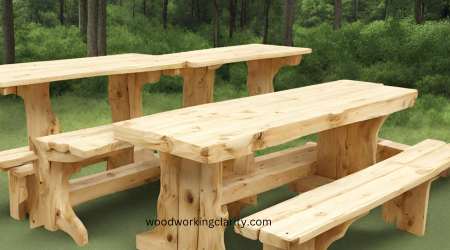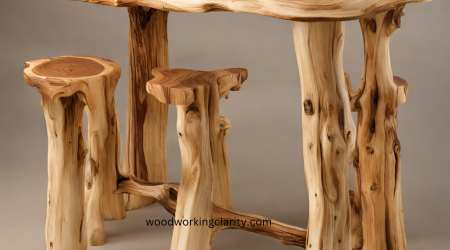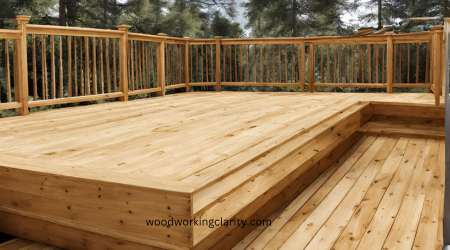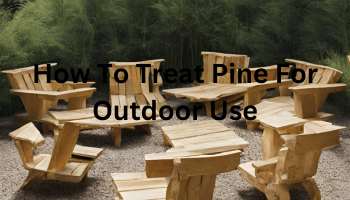Pinewood can be used for outdoor construction projects. However, there’re several important measures you’ll need to take so that the resulting structures don’t compromise on quality.
Such measures include painting, using sealants, and staining the outdoor wood. In this post, I’ll be taking you through how to treat pine for outdoor use.
The advantage of not taking preventive measures with the wood is that it’ll save you time and, of course, some bucks. But the flip side is worse; you’re sure to run into many troubles that will make you regret why you didn’t proof and give the wood the necessary protection.
How To Treat Pine For Outdoor Use

Treat pine for external use through sealing. You can seal the pine wood using either Danish oil or linseed oil, which gives the surface a light blond color. To keep your surface looking good and fresh, repeat the application at regular intervals.
Recommended read: Merits and demerits of Danish oil.
How Long Will Pinewood Last Outside
The lifespan of outdoor wood is dependent on how it has been treated. The more time spent in direct contact with water, the less long it will last outside. If left undercover, without exposure to the elements (rain, snow), pine will last significantly longer than if not!
Pinewood isn’t rot-resistant when in direct contact with water most types of pine are susceptible to decay due to their high susceptibility to Dendroctonus beetles.
However, treated pine can be protected with weathering oils or chemicals, which will increase its life span outdoors by many years!
Is It Safe To Use Untreated Pine Outside?
No, it’s not safe to use untreated wood outdoors. It’s not advisable because of the following risks:
Water
Water or moisture poses the biggest risk of using pine wood outside.
When it rains, the wood becomes wet and gets exposed to many problems like decay and molds growing inside the wood.
Outdoor wood furniture sealants help prevent decay and make it mildew resistant as they will waterproof your wood, thus granting it protection against water infiltration.
Sunlight
Sunlight is good for your wood, but too much of it is detrimental.
The sun produces UV rays which have destructive effects. The rays suck dry all the oil in the pinewood, making it fade and lose its color.
To prevent sun rays damages, apply pine wood stains with UV light blockers.
Humidity
High humidity levels are dangerous for pine wood.
When predisposed to high levels of humidity, untreated wood will accumulate moisture. As a result, it will provide breeding grounds for molds which might lead to rotting over time.
See also: Will pressure treated wood rot?
Weather Conditions
The durability of your pinewood also depends on weather and climatic conditions.
There’re areas with adverse and extreme weather conditions such that it wouldn’t be a good idea to use pine woods.
For instance, areas with intense sunlight are unfavorable since it implies heavy UV production, which isn’t good for your wood.
For places experiencing heavy downpours, the untreated wood gets wet, making them vulnerable to rot or decay, unlike pressure treated pine.
Pine Wood Alternatives: Types Of Wood Species Suitable For Outdoor Use
There’re different varieties of wood that can be used for outdoor projects. Each of the woods varies in terms of quality, durability, and function.
The durable ones possess the capacity to prevent water, decay, and rotting. Even though, I advise you to use pressure treated wood for your exterior projects.
Here are the wood species best for outdoor furniture use:
Cypress

Cypress is a wood type that has its roots in Southeast Asia and tends to do well in areas with soggy and wet soil.
It can resist decay and works well when used for marine applications such as boat docks and fence posts. Cypress wood is also stable enough to resist cracking or splitting.
Redwood
This tree is known for its strong capability to resist various weather elements. However, the wood isn’t grown everywhere, making it relatively expensive.
Cedar
It’s one of the most common wood species used on wooden structures strong enough to resist infiltration by insects and resist decay if left untreated.
However, it’s brittle and can easily be split when screwed or nailed.
Teak
The teak wood is known for its stability, quality, and durability when used for exterior usage. Its coloring won’t fade if left to sunlight exposure.
All these woods have the advantage of combining strength with protective agents such as stains and sealers.
Note: With appropriate treatment, poplar wood can be utilized for outdoor projects, but is poplar better than pinen? While poplar is generally harder than pine wood, it’s important to note that neither poplar nor pine is among the hardest hardwoods. Poplar is usually denser and boasts a higher Janka hardness rating than most pine varieties.
Also, read about the difference between pine and whitewood.
How To Treat Untreated Wood For Outdoor Use
To protect untreated wood against outdoor elements that threaten quality, use the following these instructions:
Tools And Materials Needed
- Oil-based sealant e.g. tung oil and linseed
- Sealer
- Stain
- Varnish
- Rags
- Lacquer finish
- Brush
- Outdoor polyurethane
Method 1: Use Hand-Rubbed Oil Finish
Hand-rubbed oil finishes are made from tung oil and linseed oil bases. The oil serves both a functional and aesthetic role of protecting your wood from decay and making it appealing.
To make an excellent finish:
- Stir the finish thoroughly.
- Sand the wood.
- Using a natural bristle brush apply the oil to dark-grained wood (skip this method if you’re working with a light wood such as pine because they yellow easily when hand-rubbed oils are used.)
- Let the oil soak into the surface before re-applying where you notice spots.
- Remove the excess oils using a clean rag.
- Let the wood dry for 24 hours.
- Light sand it using fine-grit sandpaper and apply another coat. Repeat the process so that your wood gets to look exactly how you want it.
Method 2: Use Sealants For Best Protection
This method involves using polyurethane, varnish, and lacquer. They work best on both light and dark-grained workpieces and possess excellent waterproofing properties.
For best results, work in a well-ventilated place at “room temperature.” Also, never shake or briskly stir sealants before use to avoid air bubbles.
The steps for applying sealants on the wood are the same as those in method one.
Method 3: Use Stain-Sealant Combo
Stain-sealant combos are hand if you’re sealing a large project, e.g., wood deck. The combos not only add color to wood surfaces but possess water resistance properties.
They have color pigments and binders, which can be oil-, water- or alkyd-based. Need a blue color? Here are some blue wood stain colors.
The downside of using this method is, reapplication is needed every year or two.
See Also:
How to Stain Pine to Look Like Oak
How To Seal Pine Wood
You need high-quality sealers to seal non-pressure treated wood.
Below are the steps that will help you to get the most out of non-pressure wood pieces:
- Check and ascertain that the wood is dry.
- Check the wood to ensure it’s in great condition and that there’re no initial signs of decay or rot.
- Clean the wood and give it 48-78 hours to dry.
- Follow the guidelines of the wood seller to apply the initial coat of the wood sealant.
- Allow the first coat to dry.
- Apply the second coat and allow it enough time to cure.
- Depending on the outcomes of the second coat, you can decide whether or not a third coat is necessary. At this point, these layers are enough to provide sufficient protection to your wood.
Maintenance Practices For pine wood
- Always work to keep the non-treated wood dry.
- Avoid accumulation of moisture on your wood so that there’s no growth of fungi; which accelerates decay and rot.
- Shade the wood.
- Don’t expose the wooden surface to excess UV rays. This will cause the oils in the wood to dry thus adversely affecting the durability of the wood
- Ensure there’s little to no moisture in the place you’ve stored your wood. If you can, limit oxygen supply so that there’re no conditions for fungal activity on the surface or around the wood.
- Weatherproof the wood using top sealing coat.
Can You Use Non Pressure Treated Pine For A Deck?
Yes, non-pressure treated wood can be used for outdoor furniture projects like wooden decks. However, you’ll need to stain, paint or seal the wood for it to withstand the harsh weather.

FAQs
How long will treated wood last outside?
Treated wood can last for as many as 40 years, especially if they’re poles. On the other, flooring and decks will last for an average of 10 years. However, these aren’t definite periods as there’re other factors at play. For instance, the quality of care and maintenance given to the wood will determine how long the wood stays outside.
How long will untreated 2×4 last outside?
Untreated 2×4 wood can last for 2 to 10 years if it’s laying on the ground. That’s a short period compared to decks or other raised projects, which can get to 40 years of service or even more. This is because the wood on the ground is constantly exposed to unfavorable conditions that make it easy to rot.
How long will untreated wood last outside?
Untreated wood will last for at most ten years when used for exterior construction projects. That’s assuming that the wood is not exposed to the ground where there’re many forces working against the stability in quality of the wood. If that’s the case, the wood will stay for five years or even less.
Read Also: Does Acacia Wood Hold up Outdoors?
How do you tell the difference between treated and untreated wood?
Look out for the green or brown tint if you want to differentiate treated and untreated lumber. If pressure treated, the lumber will have a green or brown tint acquired during chemical reactions in the treatment process. Also, treated wood will have a characteristic chemical and oily odor compared to non pressure treated lumber which will have a natural and pleasant smell. Pressure treated wood will also bear tags that identify the chemicals used in treating the wood.
Why is my pressure-treated wood turning green?
The green tint is a result of the chemical reactions that take place during the treatment of the wood. The preservative components react with the wood under the high pressure in the chamber to give rise to the green color. Copper is the most common element that’s used in this process as the wood preservative, and so the tint is attributed to it.
Is treated wood safe?
Yes, treated wood is safe for your handling and whichever use, whether exterior or interior. It doesn’t matter if you’re working on a raised garden bed or you want a simple yet playground playhouse for your children. The wood is treated using chemical preservatives that don’t pose any health hazards or effects to humans.
Final Thoughts
Can you use pine wood outdoors? As I have demonstrated in this post, pinewoods can be used for exterior construction projects. But you need to first take measures to protect wood and increase its lifespan to serve you better.
For that, you can use stains, sealers, and paints to waterproof wood. However, if you intend the structure to serve you beyond ten years, I would strongly advise that you consider using pressure-treated wood.
The wood is known to provide longevity of service since it’s protected against many of the elements that threaten the existence of its non-pressure-treated counterpart.


Will a heavy canvas tarp work for winter protection or will it trap moisture? Thanks
If it’s a breathable tarp, then it won’t trap moisture.
Thankyou for your interesting views on the treatment of pine in outdoor conditions.
I have bought six wishbone shaped cabins which I think are made of pine and which have been exposed to the elements in the north east of England for seven years and which I wish to put into good shape for hiring as holiday lets.They look in good condition but I want to make them hardy for the next few years.
Is the best way to do that to clean them first with a pressure-washer and when dry apply an oil followed by sealant then ???
I wish to keep the natural look predominantly though with some of the framework painted with interesting colour.
Can you please advise.
Are you washing the inside or outside?
Something that I’ve found will often save you from refinishing is spraying the piece with WD-40 and wiping it down with paper towels or a soft cloth.
Alternatively, use a wood cleaner ie Murphys oil soap on a rag. Or some other wood cleaner. I have seen people us degreasers , TSP,
Don’t use water on wood furniture; it raises the wood grain and breaks down the old type of glue used in most older furniture.
Hello
Does a semi-transparent blue/grey stain for outdoor for rough pine siding provide any wood protection properties at all? or is it simply for appearances?
Thanks
Hello
I have rough pine T&G siding on my new off-the-grid-remote cabin. We have many days of sunshine here in NE Ontario and it will have all-day exposure to sunlight on all sides. It should always be dry as I have an 8”W roof overhang and it will be 5’H off the ground on posts.
I would really prefer not to sand, scrape, wash or recondition the siding for 15-20 years. I could apply something once, now, but I would rather not reapply something every few years. I do want to see the pine grain and if I must stain, it would be a grey/blue that looks like weathered cabins along seashore.
Q1. Will I get any ‘protection’ from a semi-transparent stain even as it fades down the years?
Q2. and what might the grey/blue semi-transparent stain look like after many years?
Q3. If I leave untreated, I assume the pine siding will eventually turn grey/black and end up looking like barn board?
Q4. however is there any significant deterioration likely in the material before 15-20 years (when it’s not my problem, but instead my grandchildren s’ problem?!)
Q1 – Stain penetrates to add color but does not particularly protect unless it’s mixed with something else to do so. Modern pine is not particularly known as a durable outdoor wood.
Q2 – I think the siding would get wet from wind-driven rain and snow. Maybe less so at the top, so your color might be different there.
Q3 – Sure. The grey color will develop due to exposure to the elements such as microbes and sunlight, which will deteriorate the surface.
Q4 – In the end, all coatings require maintenance. The more opaque the coating, the less frequent the maintenance. Wood siding requires maintenance, coated or not. It can last a couple of decades, but there will always be repairs, replacements and affixments.
I could suggest looking into shou-sugi-ban Japanese technique that uses fire to seal and preserve wood. But I don’t know if you can do it with the boards already installed.
Would you provide some advice on what I should do for the rough pine T&G siding on my new cabin?!